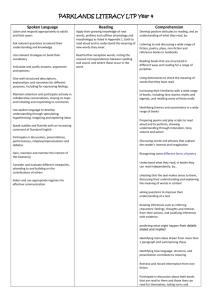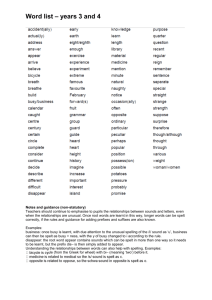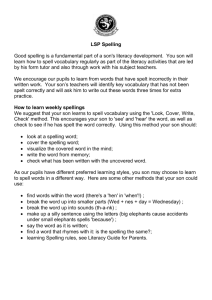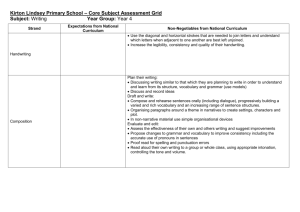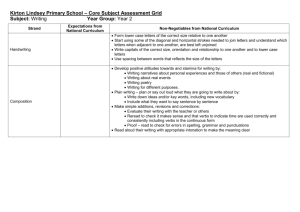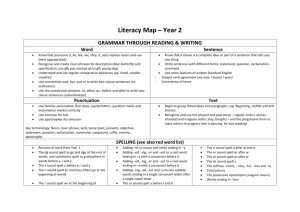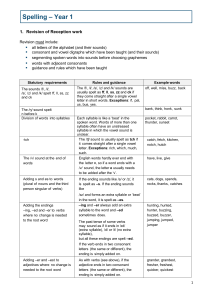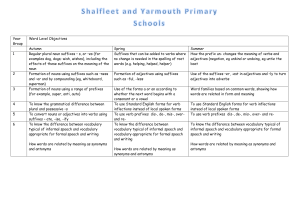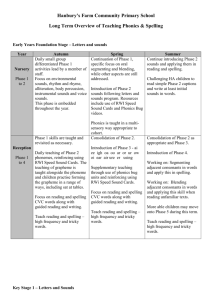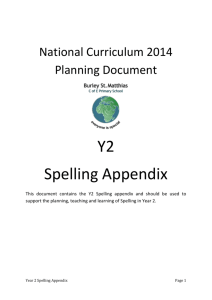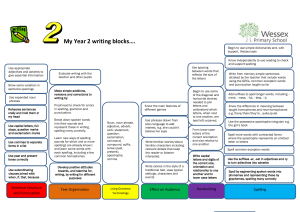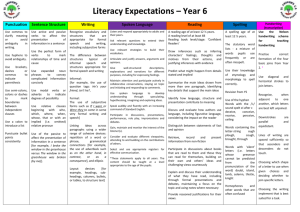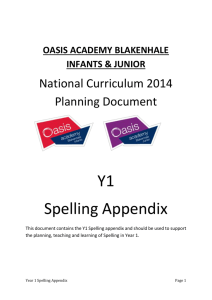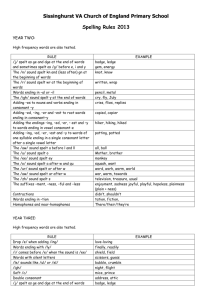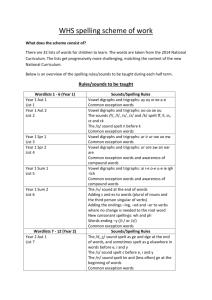Literacy - Parklands Primary School
advertisement
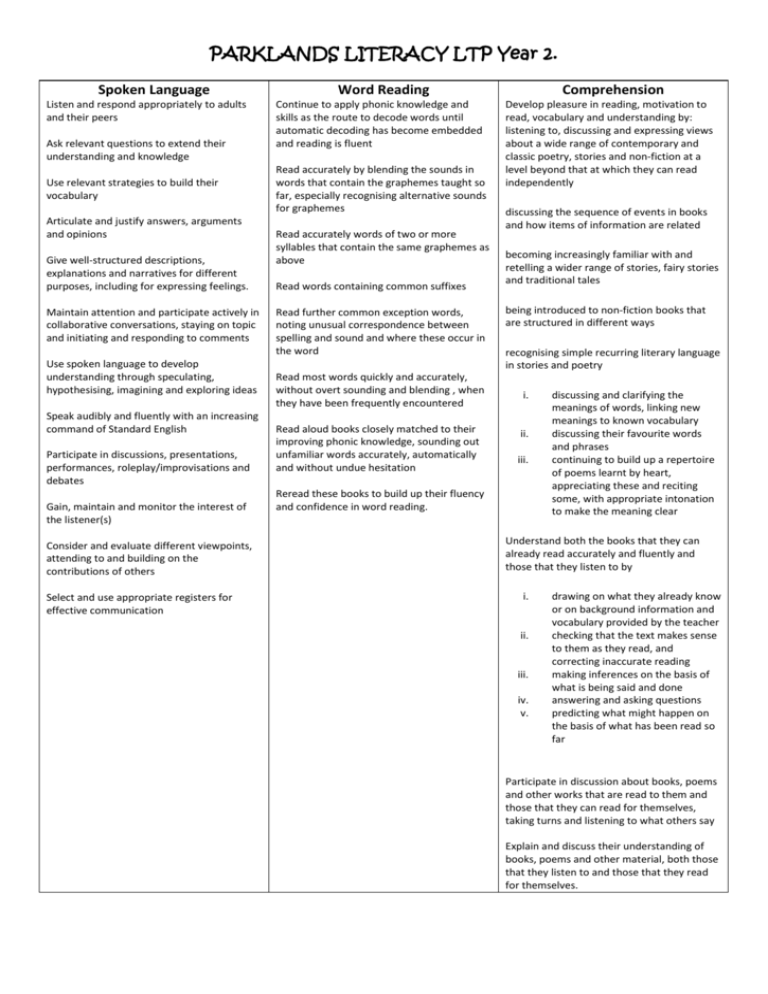
PARKLANDS LITERACY LTP Year 2. Spoken Language Listen and respond appropriately to adults and their peers Ask relevant questions to extend their understanding and knowledge Use relevant strategies to build their vocabulary Articulate and justify answers, arguments and opinions Give well-structured descriptions, explanations and narratives for different purposes, including for expressing feelings. Maintain attention and participate actively in collaborative conversations, staying on topic and initiating and responding to comments Use spoken language to develop understanding through speculating, hypothesising, imagining and exploring ideas Speak audibly and fluently with an increasing command of Standard English Participate in discussions, presentations, performances, roleplay/improvisations and debates Gain, maintain and monitor the interest of the listener(s) Consider and evaluate different viewpoints, attending to and building on the contributions of others Select and use appropriate registers for effective communication Word Reading Continue to apply phonic knowledge and skills as the route to decode words until automatic decoding has become embedded and reading is fluent Read accurately by blending the sounds in words that contain the graphemes taught so far, especially recognising alternative sounds for graphemes Read accurately words of two or more syllables that contain the same graphemes as above Read words containing common suffixes Read further common exception words, noting unusual correspondence between spelling and sound and where these occur in the word Read most words quickly and accurately, without overt sounding and blending , when they have been frequently encountered Read aloud books closely matched to their improving phonic knowledge, sounding out unfamiliar words accurately, automatically and without undue hesitation Comprehension Develop pleasure in reading, motivation to read, vocabulary and understanding by: listening to, discussing and expressing views about a wide range of contemporary and classic poetry, stories and non-fiction at a level beyond that at which they can read independently discussing the sequence of events in books and how items of information are related becoming increasingly familiar with and retelling a wider range of stories, fairy stories and traditional tales being introduced to non-fiction books that are structured in different ways recognising simple recurring literary language in stories and poetry i. ii. iii. Reread these books to build up their fluency and confidence in word reading. discussing and clarifying the meanings of words, linking new meanings to known vocabulary discussing their favourite words and phrases continuing to build up a repertoire of poems learnt by heart, appreciating these and reciting some, with appropriate intonation to make the meaning clear Understand both the books that they can already read accurately and fluently and those that they listen to by i. ii. iii. iv. v. drawing on what they already know or on background information and vocabulary provided by the teacher checking that the text makes sense to them as they read, and correcting inaccurate reading making inferences on the basis of what is being said and done answering and asking questions predicting what might happen on the basis of what has been read so far Participate in discussion about books, poems and other works that are read to them and those that they can read for themselves, taking turns and listening to what others say Explain and discuss their understanding of books, poems and other material, both those that they listen to and those that they read for themselves. Spelling Composition Spell by: Develop positive attitudes towards and stamina for writing by: segmenting spoken words into phonemes and representing these by graphemes, spelling many correctly learning new ways of spelling phonemes for which 1 or more spellings are already known, and learn some words with each spelling, including a few common homophones learning to spell common exception words learning to spell more words with contracted forms learning the possessive apostrophe (singular) distinguishing between homophones and near-homophones Add suffixes to spell longer words, including – ment, –ness, –ful, –less, –ly Apply spelling rules and guidelines, as listed in English Appendix 1 Write from memory simple sentences dictated by the teacher that include words using the GPCs, common exception words and punctuation taught so far. i. ii. iii. iv. writing narratives about personal experiences and those of others (real and fictional) writing about real events writing poetry writing for different purposes Vocabulary, grammar & punctuation Develop their understanding of the concepts set out in English Appendix 2 by: i. Consider what they are going to write before beginning by: i. ii. iii. planning or saying out loud what they are going to write about writing down ideas and/or key words, including new vocabulary encapsulating what they want to say, sentence by sentence Make simple additions, revisions and corrections to their own writing by: i. ii. iii. evaluating their writing with the teacher and other pupils rereading to check that their writing makes sense and that verbs to indicate time are used correctly and consistently, including verbs in the continuous form proofreading to check for errors in spelling, grammar and punctuation (for example, ends of sentences punctuated correctly) Read aloud what they have written with appropriate intonation to make the meaning clear learning how to use both familiar and new punctuation correctly (see English Appendix 2) , including full stops, capital letters, exclamation marks, question marks, commas for lists and apostrophes for contracted forms and the possessive (singular) Learn how to use: i. ii. iii. iv. v. vi. sentences with different forms: statement, question, exclamation, command expanded noun phrases to describe and specify the present and past tenses correctly and consistently including the progressive form subordination (using when, if, that, or because) and co-ordination (using or, and, or but) learning the grammar for year 2 in English Appendix 2 some features of written Standard English Use and understand the grammatical terminology in English Appendix 2 in discussing their writing and reading. Terminology for Children noun, noun phrase, statement, question, exclamation, command, compound, adjective, verb, suffix, adverb, tense (past, present) apostrophe, comma Spellings English Appendix 1 Handwriting and Presentation Revision of Year One Work The sound spelt as ge and dge at the end of words, and sometimes spelt as g elsewhere in words before e, i and y /dʒ/ The /s/ sound spelt c before e, i and y The /n/ sound spelt kn and (less often) gn at the beginning of words The /r/ sound spelt wr at the beginning of words The /l/ or /əl/ sound spelt –le at the end of words The /l/ or /əl/ sound spelt –el at the end of words The /l/ or /əl/ sound spelt –al at the end of words Words ending –il The sound spelt –y at the end of words /aɪ/ Adding –es to nouns and verbs ending in –y Adding –ed, –ing, –er and –est to a root word ending in –y with a consonant before it Form lower-case letters of the correct size relative to one another Start using some of the diagonal and horizontal strokes needed to join letters and understand which letters, when adjacent to one another, are best left unjoined Write capital letters and digits of the correct size, orientation and relationship to one another and to lower-case letters Use spacing between words that reflects the size of the letters Adding the endings –ing, –ed, –er, –est and – y to words ending in –e with a consonant before it Adding –ing, –ed, –er, –est and –y to words of one syllable ending in a single consonant letter after a single vowel letter The ɔsound spelt a before l and ll / :/ The sound spelt o /ʌ/ The /i:/ sound spelt –ey The sound spelt a after w and qu /ɒ/ The sound spelt or after w /ɜ:/ The sound spelt ar after w /ɔ:/ The sound spelt s /ʒ/ The suffixes –ment, –ness, –ful , –less and –ly Contractions The possessive apostrophe (singular nouns) Words ending in –tion Homophones and near-homophones Common exception words
